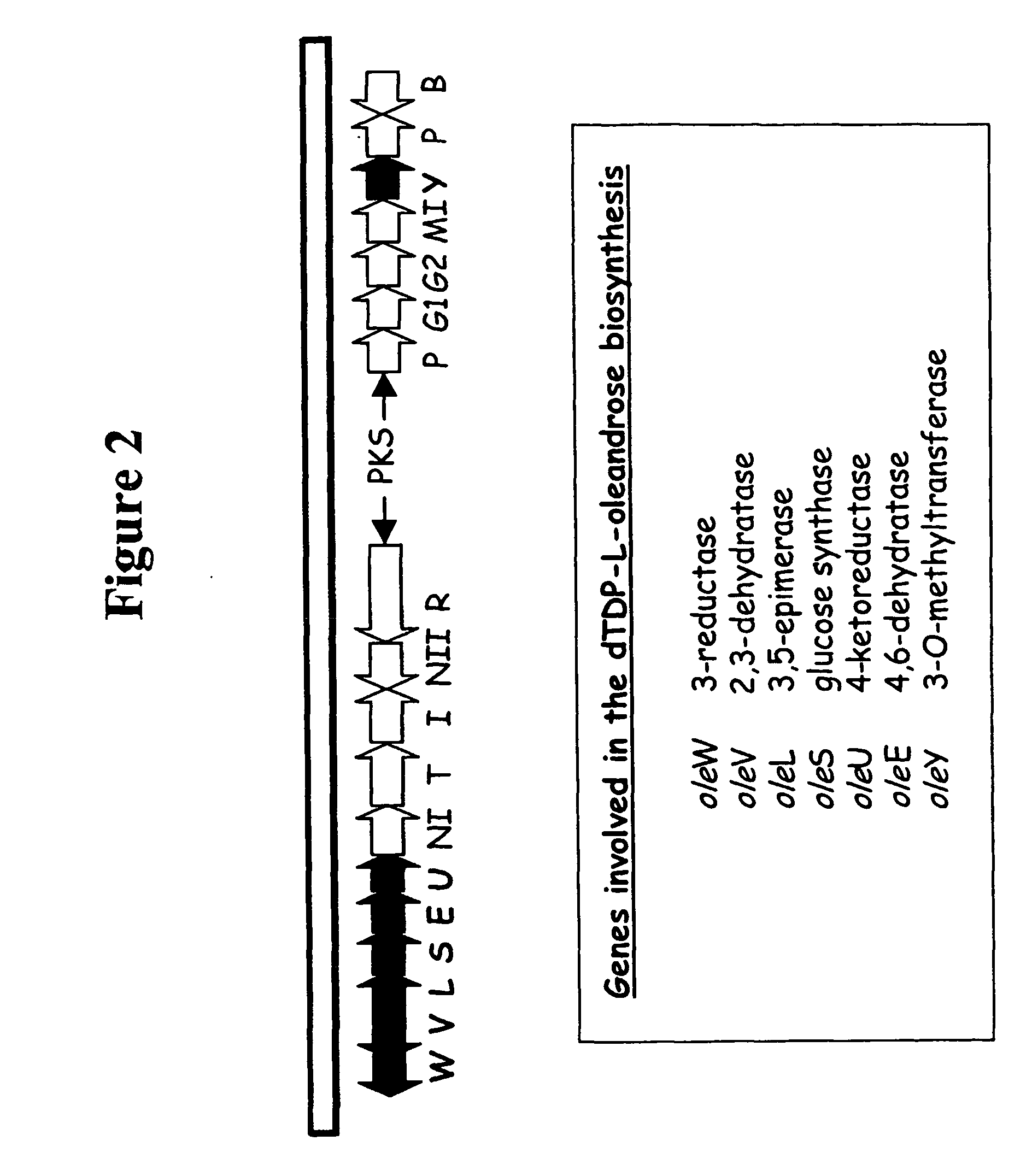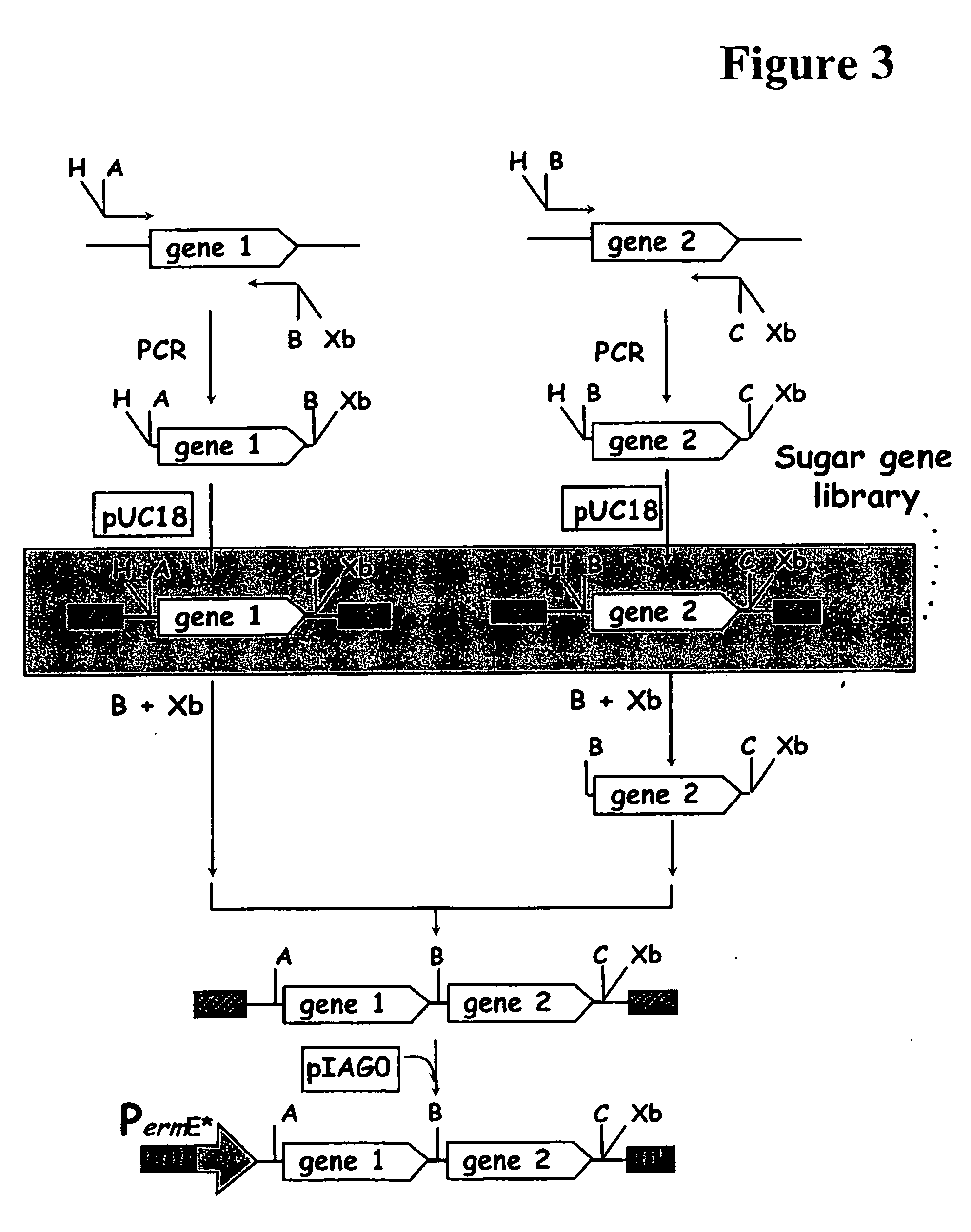Hybrid glycosylated products and their production and use
a glycosylated product and hybrid technology, applied in the direction of peptides, drug compositions, immunological disorders, etc., can solve the problems of time-consuming and costly procedures, inexorable rise in the incidence of pathogenic organisms, etc., and achieve the effect of facilitating gene exchang
- Summary
- Abstract
- Description
- Claims
- Application Information
AI Technical Summary
Benefits of technology
Problems solved by technology
Method used
Image
Examples
example 2
Functionality of pLN2
[0073]S. albus 16F4, S. albus GB16 and S. lividans NAG2 were transformed with pLN2 encoding the biosynthetic pathway for the production of L-olivose (see Materials and Methods above). S. albus 16F4+pLN2 was found to produce a compound consistent with L-olivosyl-tetracenomycin C (LOLV-TCMC) in terms of HPLC mobility and absorption spectrum when compared with the pure compound used as standard (Table 3). S. albus GB16+pLN2, when fed with 8DMTC, converted the aglycone to a compound consistent with LOVL-TCMC in terms of HPLC mobility and absorption spectrum when compared with the pure compound used as standard (Table 3). MALDI-TOF analysis of this compound showed molecular peaks at m / z 611.0815 and 627.0728 for the sodium and potassium adducts of LOVL-TCMC, respectively (Table 3). The reporter system providing endogenous 8DMTC (S. albus 16F4) showed a greater efficiency of conversion to LOVL-TCMC (64%) compared to the biotransformation system (S. albus GB16) with o...
example 3
Screening of Heterologous 4-ketoreductases in pLN2 Acting on L-6-deoxysugar Intermediates
[0074] The 4-ketoreductase encoded by oleU was replaced, as described in the Material and Methods above and FIG. 8, with one of the following heterologous 4-ketoreductases eryBIV or snogC of the erythromycin and nogalamycin clusters, respectively (Table 1). These reductases act on different sugar intermediates to OleU, but share the same C4 ketoreductase stereospecificity.
[0075] Replacement of oleU with eryBIV (pLN2 derivative pLNBIV) gave rise to a new HPLC peak in both reporter systems S. albus 16F4 and S. albus GB16 (described in Example 1), with the conversion of 8DMTC at levels of 20% and 3% respectively. This new compound was consistent with LOLV-TCMC in terms of HPLC mobility and absorption spectrum when compared with the pure compound used as standard (Table 3). MALDI-TOF analysis of this compound showed molecular peaks at m / z 611.0815 and 627.0728 for the sodium and potassium adducts ...
example 4
Screening of Heterologous 4-ketoreductases in pLN2 Acting on D-6-deoxysugar Intermediates
[0079] The 4-ketoreductase TylD acts on D-6deoxysugar intermediates but has the same stereospecificity at C-4 as OleU (Table 1). No glycosylation of 8DMTC was observed on replacement of oleU with tylD (pLN2 derivative pLNT) in the S. albus or S. lividans host strain reporter systems.
PUM
| Property | Measurement | Unit |
|---|---|---|
| Volume | aaaaa | aaaaa |
| Digital information | aaaaa | aaaaa |
Abstract
Description
Claims
Application Information
 Login to View More
Login to View More - R&D
- Intellectual Property
- Life Sciences
- Materials
- Tech Scout
- Unparalleled Data Quality
- Higher Quality Content
- 60% Fewer Hallucinations
Browse by: Latest US Patents, China's latest patents, Technical Efficacy Thesaurus, Application Domain, Technology Topic, Popular Technical Reports.
© 2025 PatSnap. All rights reserved.Legal|Privacy policy|Modern Slavery Act Transparency Statement|Sitemap|About US| Contact US: help@patsnap.com



